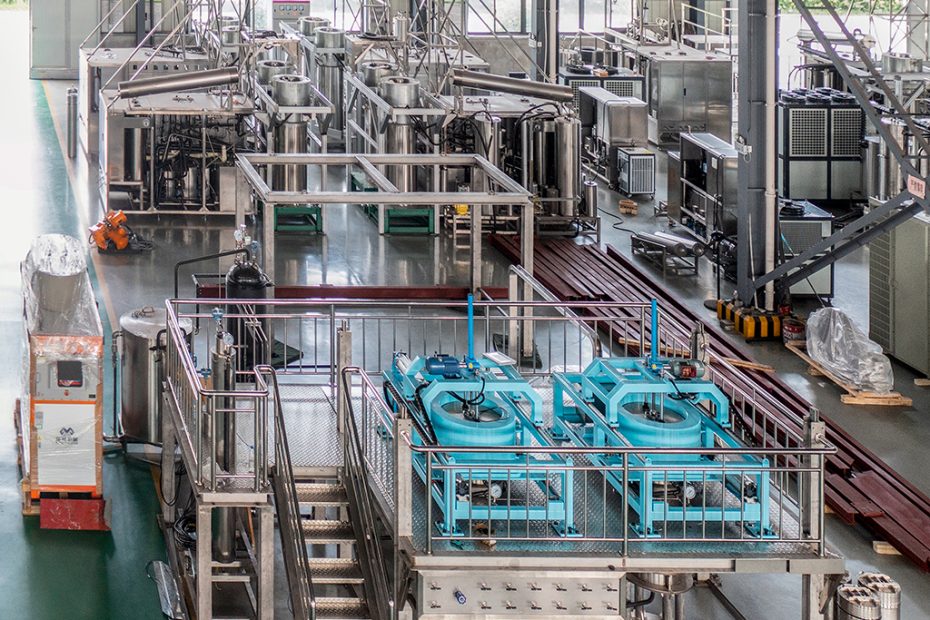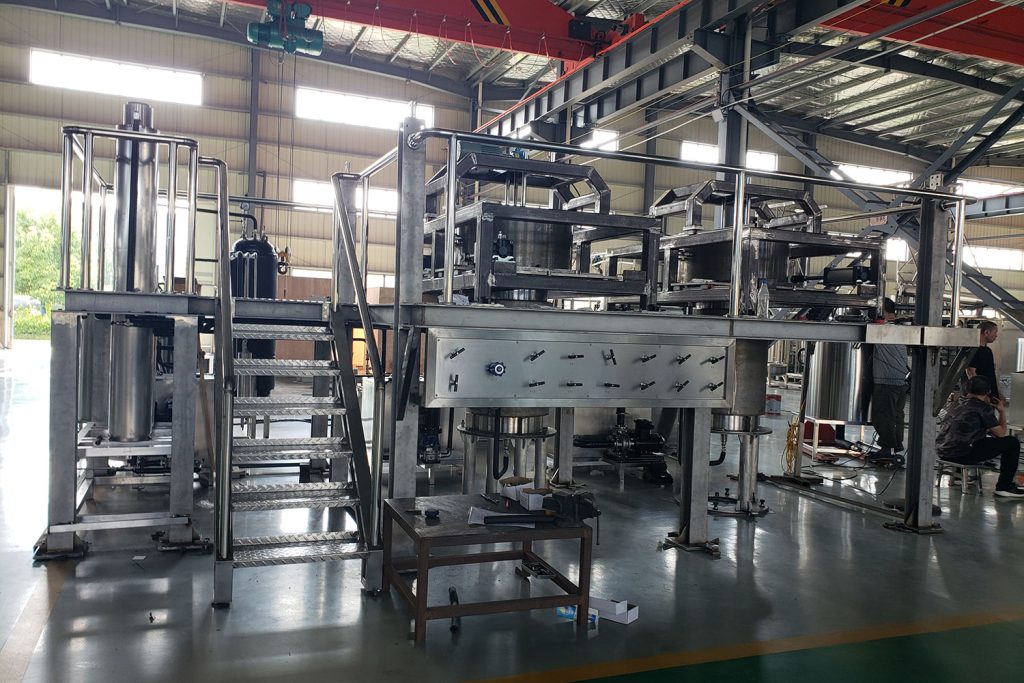Supercritical carbon dioxide (CO2) extraction is an advanced and versatile technique that enables the extraction and purification of a wide range of compounds, both solid and liquid, under high-pressure and controlled temperature conditions. This process offers numerous advantages, making it a preferred method for industries involved in extracting valuable materials.
Supercritical CO2 extraction process is a sophisticated and highly efficient method used to extract a wide range of materials, both solid and liquid, under specific conditions of high pressure and temperature. This technique has become pivotal in various industries for its ability to obtain pure and valuable compounds while maintaining environmental sustainability.
Components of Supercritical CO2 Extraction macnine System
The entire supercritical CO2 extraction device system comprises several essential components and auxiliary equipment to ensure efficient extraction and separation processes. These components include:
1. Extractor
The extractor is the heart of the supercritical CO2 extraction machine system. It is a vessel where the raw material to be extracted is placed. This vessel is designed to withstand high pressures and temperatures, ensuring that the CO2 remains in its supercritical state throughout the process. The extractor often features intricate designs, such as baskets or trays, to facilitate the even distribution of CO2 through the material.
The extractor’s design and construction are critical as it must handle the extreme conditions of supercritical CO2, which occurs at pressures above 72.9 atmospheres and temperatures above 31.1°C. The material within the extractor undergoes the extraction process, during which the supercritical CO2 passes through it, dissolving and carrying away the target compounds.
2. Separator
After the supercritical CO2 has interacted with the raw material and dissolved the target compounds, the next crucial step is the separation of these compounds from the CO2. This is where the separator comes into play. The separator’s primary function is to isolate the extracted components from the supercritical CO2, allowing for the collection of the valuable target products.
The separator employs a combination of pressure reduction and temperature adjustments to transition the supercritical CO2 back into a gaseous state. As it does so, the target compounds lose their solubility and precipitate out of the CO2, forming a mixture that can be collected separately. This process is known as phase separation and is vital for obtaining the desired substances with high purity.
3. CO2 High-Pressure Pump
Supercritical CO2 extraction relies on achieving and maintaining specific conditions of pressure and temperature. The CO2 high-pressure pump is responsible for pressurizing the carbon dioxide to the required levels for it to reach the supercritical state. The critical point of CO2, where it becomes supercritical, occurs at a pressure of 72.9 atmospheres and a temperature of 31.1°C. This pump ensures that the CO2 is in the supercritical phase, allowing it to efficiently interact with the raw material within the extractor.
4. Co-solvent Pump
In some extraction processes, it is necessary to enhance the solubility and selectivity of the supercritical CO2 by introducing co-solvents. Co-solvents are secondary substances that, when added to the supercritical CO2, can improve the extraction efficiency for specific compounds. The co-solvent pump plays a crucial role in injecting and controlling the flow of these co-solvents into the system.
The selection of the co-solvent depends on the nature of the target compounds and the desired outcomes of the extraction. Co-solvents can be liquids that have different solubility properties than supercritical CO2, and they are carefully chosen to complement the extraction process.
5. Cooling System
Maintaining precise temperature control is essential in supercritical CO2 extraction. The cooling system is responsible for regulating and controlling the temperature within the extraction system. It ensures that the supercritical CO2 and the extracted material remain at the desired temperature for the extraction process.
The cooling system typically consists of various components, including heat exchangers, refrigeration units, and temperature sensors. These components work together to keep the temperature within the extractor at the optimal level, which is specific to the material being processed.
6. Heat Exchange System
The heat exchange system is a critical component that complements the cooling system. It plays a pivotal role in maintaining the desired temperature conditions within the extraction system. This system operates by efficiently managing the heat generated during the extraction process, preventing temperature fluctuations and ensuring a stable and controlled environment.
The heat exchange system is particularly important because variations in temperature can impact the efficiency and quality of the extraction. By carefully managing heat exchange, it helps to maintain the optimal temperature for the dissolution of target compounds in the supercritical CO2.
7. CO2 Storage Tank
For a continuous and uninterrupted extraction process, a reliable source of supercritical CO2 is essential. This is where the CO2 storage tank comes into play. It serves as a reservoir for the carbon dioxide, ensuring a steady supply throughout the extraction operation.
The storage tank is designed to withstand the high pressure required for the supercritical CO2 state and provides a constant source of CO2 that can be pumped into the extraction system as needed. This seamless supply of CO2 is a key factor in the success of the extraction process.
8. Liquid Level Gauge
A liquid level gauge is a crucial monitoring tool in the supercritical CO2 extraction system. It provides real-time information about the liquid level within the system, allowing operators to monitor and adjust the process as necessary.
Maintaining the correct liquid level is essential to the efficiency and safety of the extraction process. The liquid level gauge offers precise measurements, ensuring that the extractor remains adequately filled and preventing any interruptions in the extraction process.
9. Purification Filter System
The purification filter system plays a vital role in ensuring the purity of the extracted compounds. It is designed to remove impurities, contaminants, and any particles that may have been carried over during the extraction process.
This filtration process is essential for producing high-quality and pure extracts. The purification filter system ensures that the final product is free from unwanted substances, contributing to the overall effectiveness and safety of the extraction.
10. Flow Meter
Flow meters are indispensable instruments in the supercritical CO2 extraction system. They are responsible for accurately measuring the flow of supercritical CO2 and any other substances within the system. These measurements are crucial for maintaining precise control over the extraction process.
Flow meters are used to monitor the flow rates of CO2, co-solvents, and other fluids within the system. This data is essential for ensuring that the desired conditions of pressure, temperature, and flow rates are maintained, resulting in consistent and efficient extractions.
11. Temperature Control System
Precise temperature control is a critical factor in supercritical CO2 extraction. The temperature control system is designed to provide operators with the tools and mechanisms needed to maintain a stable and controlled environment within the extraction system.
This system allows for the adjustment of temperature as required for the specific material being processed. Temperature control is a fundamental parameter in the solubility of different compounds in supercritical CO2, making it a key element for the successful extraction of target substances.
12. Safety Protection System
The safety of operators and equipment is paramount in any industrial process, and supercritical CO2 extraction is no exception. The safety protection system is integrated to ensure the well-being of personnel, protect the equipment, and minimize the risks associated with high-pressure and high-temperature operations.
This system includes various safety features such as pressure relief valves, emergency shut-off mechanisms, and alarms to signal any deviations from safe operating conditions. It is crucial in preventing accidents and ensuring that the extraction process is carried out safely.
Top 7 Features of Supercritical CO2 Extraction
The supercritical CO2 extraction process offers a range of features that make it a highly desirable method for various industries:
1. Low Critical Temperature
- Supercritical CO2 has a relatively low critical temperature, making it suitable for the extraction and purification of heat-sensitive compounds. This feature ensures that temperature-sensitive compounds are not degraded during the process.
2. Inert Environment
- The use of supercritical CO2 provides an inert environment, which prevents product oxidation. This inert atmosphere is vital for preserving the effective content of the extract, especially in industries dealing with delicate compounds.
3. Non-toxic and Non-flammable
- Supercritical CO2 is non-toxic, non-flammable, and safe to use. It poses no risk to operators and does not contribute to environmental pollution.
4. No Solvent Residue
- One of the significant advantages of supercritical CO2 extraction is that it leaves no solvent residue in the extracted material. This ensures the purity of the final product.
5. No Nitrates and Heavy Metal Ions
- Supercritical CO2 extraction does not introduce nitrates or heavy metal ions into the extracted compounds, making it a preferred choice for industries concerned with product purity.
6. Carbon Dioxide Recycling
- CO2 used in the extraction process can be efficiently recycled and reused, reducing both cost and environmental impact.
7. Customizable Pressure and Temperature
- The pressure and temperature in a supercritical CO2 extraction system can be tailored to meet the specific requirements of the material being processed. This flexibility makes it a versatile method for a wide range of applications.
Top 6 Applications of Supercritical CO2 Extraction
Supercritical CO2 extraction finds applications in various industries due to its unique advantages. Some of the notable applications include:
- Pharmaceutical Industry : Supercritical CO2 extraction is widely used in the pharmaceutical industry for the extraction of active pharmaceutical ingredients (APIs), ensuring the purity and efficacy of drugs.
- Food and Beverage Industry : In the food and beverage industry, this method is employed to extract flavors, fragrances, and bioactive compounds from natural sources.
- Essential Oils : Essential oil producers utilize this technique to extract essential oils from plants without the use of chemical solvents, preserving the natural essence of the oils.
- Environmental Remediation : Supercritical CO2 extraction plays a role in environmental cleanup efforts by removing pollutants and contaminants from soil and water.
- Nutraceuticals : The nutraceutical industry relies on this method to extract bioactive compounds from natural sources for dietary supplements and health products.
Conclusion
Supercritical CO2 extraction process is a groundbreaking technology that offers numerous benefits, including its ability to handle heat-sensitive compounds, provide an inert environment, and maintain product purity. Its non-toxic and non-flammable nature, along with the capacity for CO2 recycling, makes it a green and sustainable choice for various industries. As technology continues to advance, supercritical CO2 extraction will likely see even more applications and become increasingly integral to many sectors.

